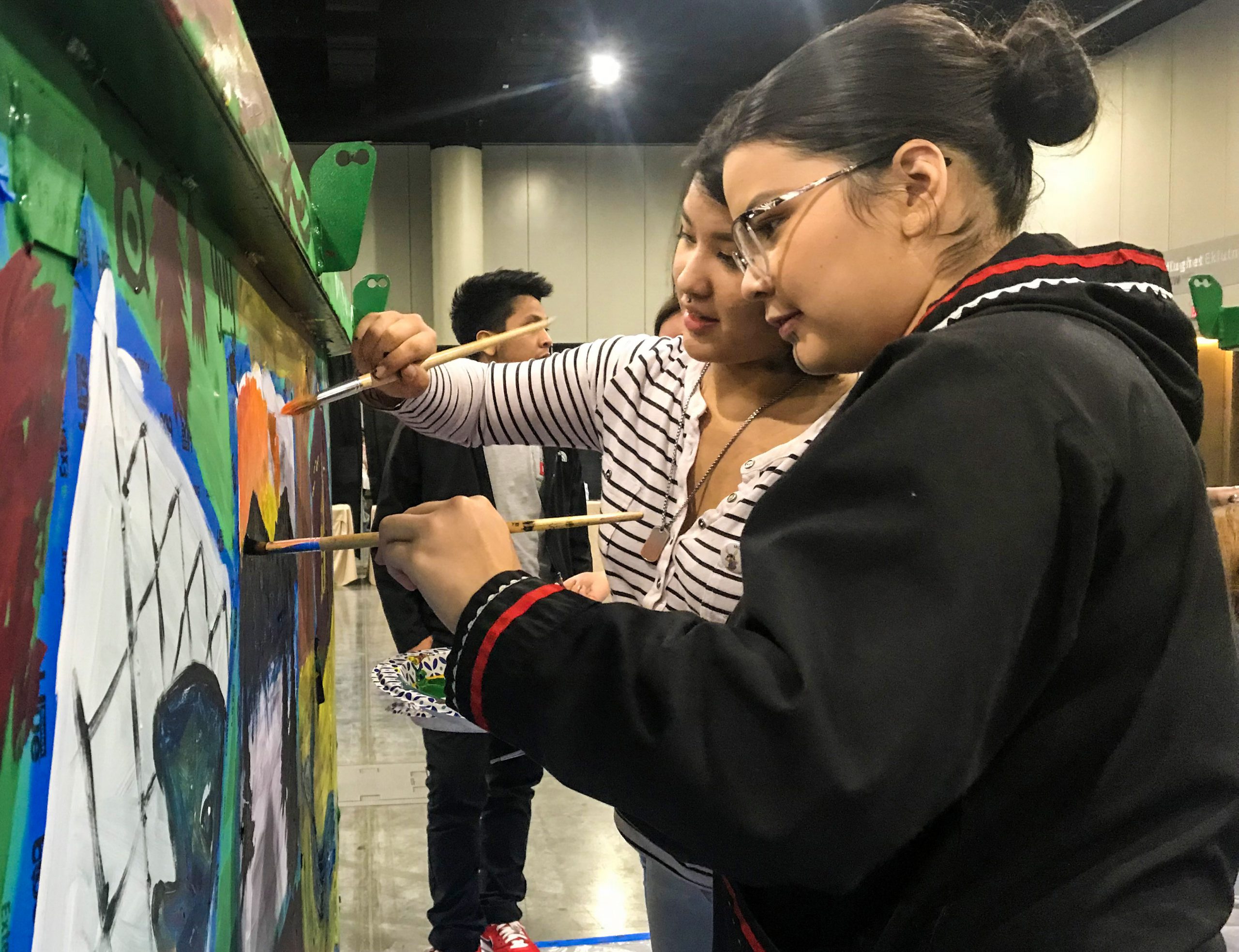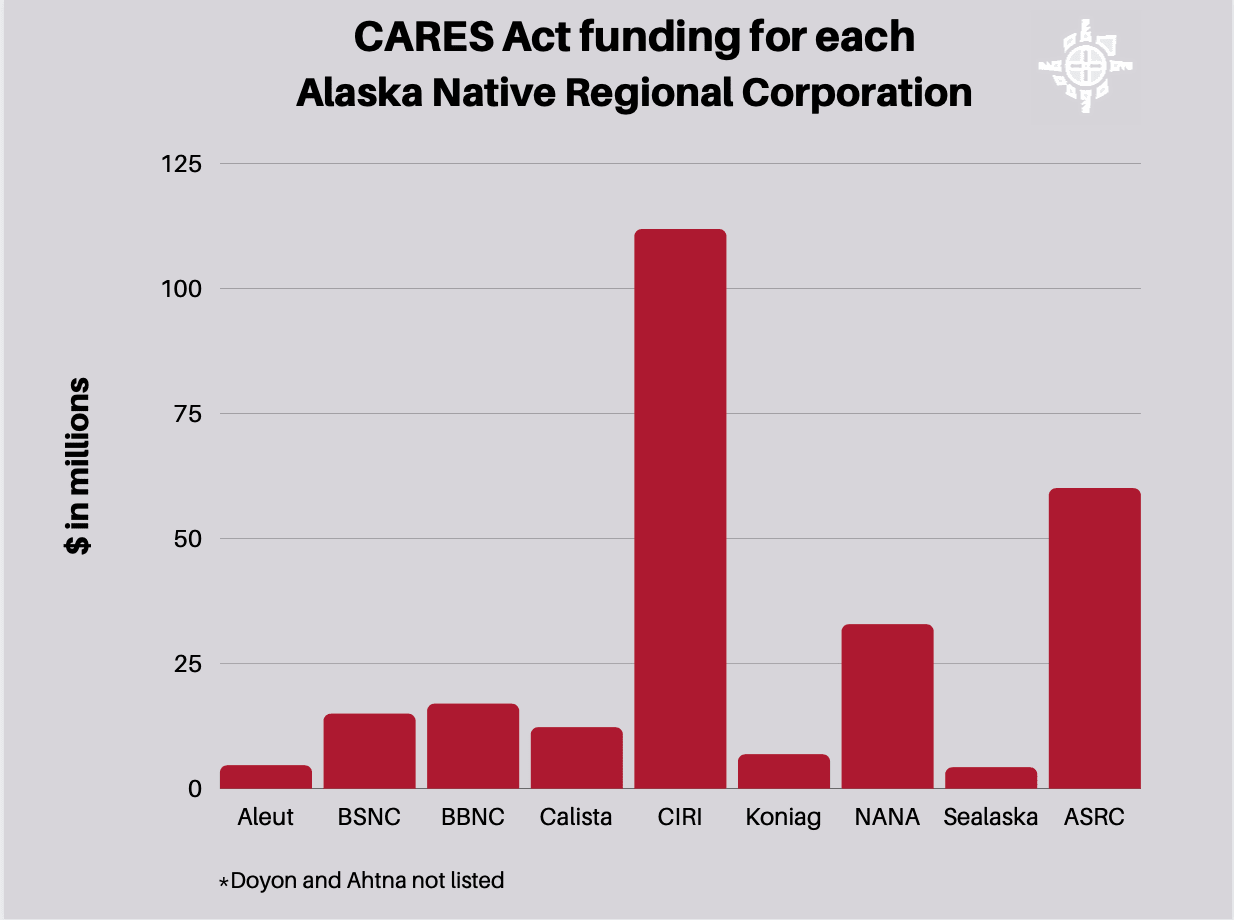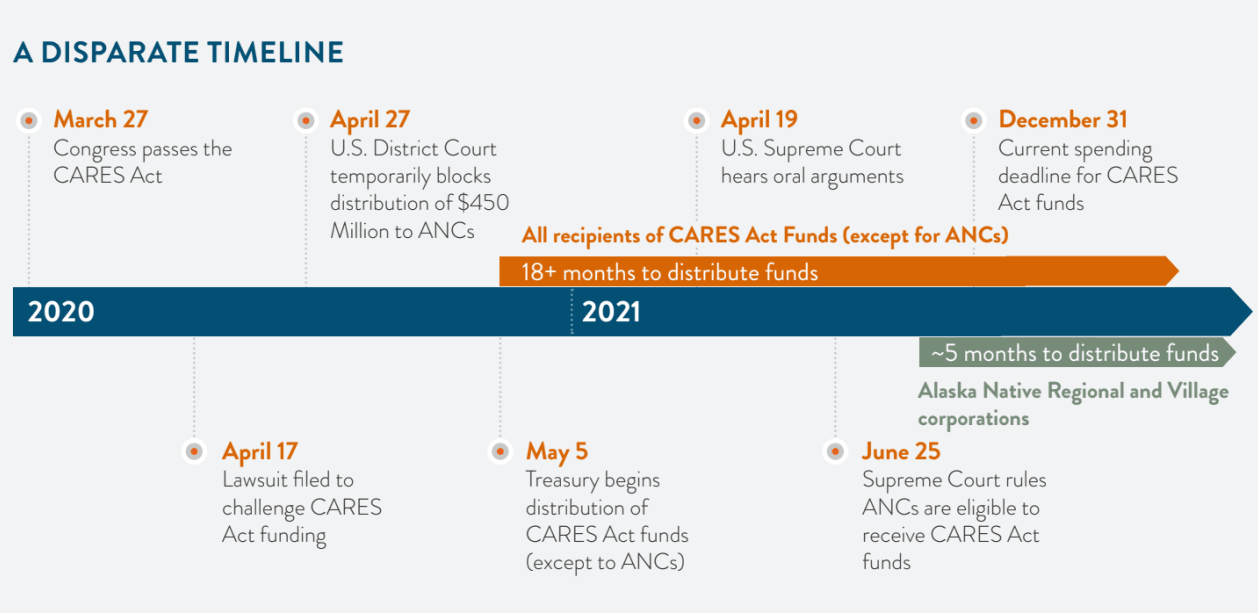Indianz.Com > News > Indian Country Today: Alaska Native corporations finally receive COVID-19 funds

Following the coronavirus relief funds in Alaska
Alaska Native corporations are figuring out how to distribute the funds more than a year after the CARES Act lawsuit started
Monday, September 27, 2021
Indian Country Today
The Supreme Court announced that Alaska Native corporations were eligible for CARES Act funding in June, after a year of legal conflicts surrounding the issue.
The decision was widely celebrated by impacted Alaska Native organizations that stated the stalled relief funds negatively affected an already at-risk community during the height of the pandemic. Now, the corporations are moving on to phase two of the process: determining how they can best use the final funding amount they each received.
“There’s a significant amount of need in our region, and among Alaska Native and American Indian people. And it’s a huge responsibility for CIRI, as well as our sister [corporations] and our partner organizations to responsibly get this money and these resources out to where they’re needed most, as expeditiously as possible,” said Ethan Tyler, director of corporate affairs for CIRI, one of the 13 Alaska Native regional corporations.
Overall, 13 Alaska Native regional corporations and more than 150 village corporations received nearly $450 million in relief funds. They have until December 31, 2021, to spend it, according to the CARES Act legislation.
Most of the corporations are planning to deploy a combination of individual shareholder payments and donations to larger assistance programs. First, they will distribute dividends directly to shareholders, based on who experienced financial setbacks during the pandemic. The remaining funds will then go towards other community initiatives, unless the corporations set aside a predetermined amount.
“We want to ensure that 100 percent of the CARES Act funding that we received benefits our shareholders and descendants who’ve been impacted. And so Koniag is absorbing 100 percent of any cost associated with administering our CARES Act funding,” said Shauna Hegna, Alutiiq, President of Koniag.

Looming Deadline
Although the drawn out lawsuit is resolved, CARES Act challenges still remain. Alaska Native corporations have been working on their fund deployment strategies since May of 2020. But despite this preparation time, they are still facing distribution obstacles.
Some challenges are unique to Alaska. For one, the corporations have to circulate application information to thousands of shareholders, many of which live in extremely remote areas with unreliable broadband and internet access. This makes online application processes, like those needed for direct payments or mental health vouchers, more difficult to implement on a short timeline.
Others are common pandemic era challenges. Supply chain delays and operational lulls make any sort of distribution difficult, says Tyler.
“A higher infection rate among Alaska Native population, extreme delays to the global supply chain, and a strain on our rural social support services are just some of the realities we as Alaska Native people are up against as we race to meet the spending deadline,” read a statement from the Alaska Native Corporation Regional Association.
These logistical complications might have been manageable on their own, given that the corporations are used to operating over vast distances and shaky digital connections. But the looming December 31 deadline to use CARES Act resources makes already existing difficulties much worse. The corporations only found out this summer how much money they’d be receiving. Now, they’ll have to distribute those assets within a few months, while other organizations that received the relief funds were given over a year to do so.
“There are still Alaska Native corporations that have not received their funds. It’s an extraordinary challenge that we’re facing in Alaska right now,” Hegna said.
While the corporations rush to distribute resources in time, COVID has resurfaced in Alaska. The state now has the highest case rate per capita of any U.S. state, putting additional stressors on an already at-risk community.
Several corporations are calling on Congress to extend the deadline in light of the struggles.
“An extension would allow some of those supply chain bottlenecks to break up a little bit, and provide the most benefit for the people and organizations that need it up here,” Tyler said.

Payout Disparities
As the corporations focus on providing resources before the deadline, others’ attention has been directed at drastic differences in CARES Act payouts.
Alaska Native corporations received nearly $450 million in relief funds in total. However, this amount wasn’t split evenly between the state’s regional and village corporations.
In certain cases, the variance is stark: the regional corporation Sealaska only received $4.2 million, even though they have the most shareholders. In comparison, the regional corporation CIRI received around $112 million. The allocation translates to roughly $12,000 per shareholder, if they were to use the entire amount for direct dividends.
The imbalance is clear on the village corporation level as well. Yak-Tat Kwaan, Inc, a village corporation in the southeast community Yakutat, said their allocation was around $164,000, while the village corporation Kootznoowoo, Inc. only received around $168,625. Meanwhile, the urban corporation Goldbelt, Inc. collected nearly $11.1 million — significantly more than its peer companies, and more than double the amount that the larger regional corporation Sealaska received. Goldbelt has around 4,000 shareholders, while Yak-Tat Kwaan has around 500 and Kootznoowoo has around 450, compared to Sealaska’s 20,000 shareholders.
On social media, shareholders voiced their concerns and confusion about the contrasting numbers. Considering the range in payout amounts and shareholder numbers, the direct relief dividends will look different in each region. Some will receive less than $150 in aid, while others will collect upwards of $1,000.
Neither corporate leaders nor Alaskan’s delegation knew how the funds would be distributed before the state received them. Some Alaskans had assumed it would be based on shareholder population size, seeing as those corporations have more people to look out for. Others speculated that it might be related to the revenue of the corporation, since those with larger profits could potentially provide more benefits to shareholders without assistance.
In the end, neither theory was correct. The formula was determined by the Treasury Department, and involved the same criteria used to allocate funding to tribes in the Lower 48 and Alaska. An announcement from the department says the payouts were based on factors such as employee base and total housing services provided, but a complete overview wasn’t provided. The Treasury’s allocation process left some with questions. Nathan McCowan, Tlingit and Haida, who is chair of the Alaska Native Village Corporation Association, told Alaska Public Media that requests for more information have gone unanswered. “They were translucent, but not transparent,” he said. The department also declined an invitation to meet with Koniag about the topic, according to Hegna. “Koniag is incredibly grateful for the assistance that we received through the CARES Act. We’re not seeking to challenge the allocation, but simply to understand the methodology that was used,” she explained. The Department of Treasury confirmed they used the same formula for Alaska Native corporations as they did for tribes, which was based on population numbers listed in the Department of Housing and Urban Development in connection with the Indian Housing Block Grant program, and modeled off of Census data. But while the differences in payments may initially be shocking, it doesn’t paint the entire picture. One may need to look beyond individual allocations to get a sense of the CARES Act funding’s total impact on the community. Donations that didn’t go to individual dividends could help the population at large. For example, CIRI received the highest CARES funding amount, but they also serve the most populated part of the state, including Anchorage, the largest city. Subsequently, their program donations have the potential to benefit thousands, according to a CIRI representative. Some funding will also bolster pre-existing work between the corporations, tribes, and health consortiums. Take Koniag, which plans to donate $1 million towards their regional tribal health organization to cover much needed covid-19 vaccinations and testing costs. Perhaps most notably, many regional corporation shareholders will also be receiving individual dividends from their tribe and / or village corporation. This could explain why regional corporations like Sealaska received a lower amount. As a Sealaska press release pointed out, their region received federal relief — just through different channels, since much of it was directed to tribes. “Funding flowed to our region to benefit our people – it just flowed primarily through tribes rather than through Sealaska. Some have asked why CIRI and Doyon received so much more than Sealaska. The reason is that in their large population centers, they provide more of the housing-related services in their regions,” a Sealaska press release said. In Sealaska’s Southeast region, tribes are the major provider of Alaska Native housing services, rather than non-profits connected to the corporations. In this case, their tribes may have received a significant portion of the CARES Act funding rather than the corporations, while in other regions it was opposite — the corporations received more funding while the tribes received less. Either way, the funding is benefitting the same populations, just through different distribution channels. Despite potential financial imbalances between the regions, Hegna views the long-awaited CARES Act funding as a critical win for the entire Alaska Native community. “We are so happy for every fund that all of our sister regional corporations and village corporations received — because those funds were needed, and they’re going to help our Alaska Native people,” she said.Find the U.S. Supreme Court decision in Yellen v. Confederated Tribes of Chehalis Reservation here. #SupremeCourt #CARESAct #CoronavirusReliefFund #COVID19 #Coronavirus #SelfDetermination #Sovereigntyhttps://t.co/LaIhtt54W2
— indianz.com (@indianz) June 25, 2021
U.S. Supreme Court Decision: Yellen v. Confederated Tribes of Chehalis Reservation
Syllabus |
Opinion [Sotomayor] | Dissent [Gorsuch] | Full Document
Meghan Fate Sullivan, Koyukon Athabascan, is a former Stanford Rebele Fellow turned special correspondent for Indian Country Today, currently reporting on and producing ICT’s ANCSA 50 project. She grew up in Alaska, and reports on her home state from our Anchorage Bureau. Follow her on Twitter @mfatesully.
This story originally appeared on Indian Country Today, a nonprofit news organization. Will you support their work? All of ICT’s content is free. There are no subscriptions or costs. And ICT has hired more Native journalists in the past year than any news organization ─ and with your help we will continue to grow and create career paths for our people. Support Indian Country Today for as little as $10.
Search
Filed Under
Tags
More Headlines
House Subcommittee on Indian and Insular Affairs gains new Republican leader
Native America Calling: Ringing in the Orthodox New Year in Alaska
Schedule of Senate committee hearings for Donald Trump nominees
‘Governor Burgum will serve Indian Country well’: Senate committees busy with Donald Trump’s nominees
NAFOA: 5 Things You Need to Know this Week
Chuck Hoskin: Cherokee Nation sees bright future for language programs
Native America Calling: Native in the Spotlight with Ted Nolan
Neal McCaleb, prominent citizen of Chickasaw Nation, passes on after storied career
South Dakota Searchlight: Tribes seek protection for Wounded Knee Massacre site
Arizona Mirror: Tribes receive climate resilience grants
Native America Calling: Native skiers
Alaska Beacon: Republicans still pushing to drill in Arctic National Wildlife Refuge
Iowa Capital Dispatch: Democrats object to hearing for Trump’s Interior nominee
North Dakota Monitor: Tribes share priorities with state lawmakers
Cronkite News: Indigenous Enterprise brings culture to New York City
More Headlines
Native America Calling: Ringing in the Orthodox New Year in Alaska
Schedule of Senate committee hearings for Donald Trump nominees
‘Governor Burgum will serve Indian Country well’: Senate committees busy with Donald Trump’s nominees
NAFOA: 5 Things You Need to Know this Week
Chuck Hoskin: Cherokee Nation sees bright future for language programs
Native America Calling: Native in the Spotlight with Ted Nolan
Neal McCaleb, prominent citizen of Chickasaw Nation, passes on after storied career
South Dakota Searchlight: Tribes seek protection for Wounded Knee Massacre site
Arizona Mirror: Tribes receive climate resilience grants
Native America Calling: Native skiers
Alaska Beacon: Republicans still pushing to drill in Arctic National Wildlife Refuge
Iowa Capital Dispatch: Democrats object to hearing for Trump’s Interior nominee
North Dakota Monitor: Tribes share priorities with state lawmakers
Cronkite News: Indigenous Enterprise brings culture to New York City
More Headlines